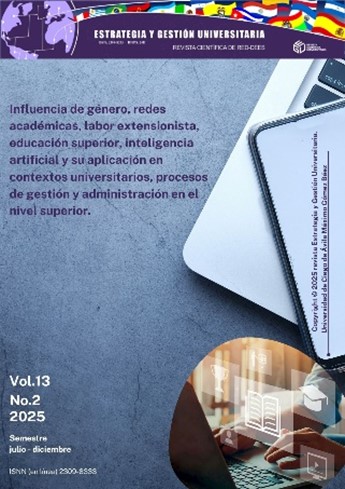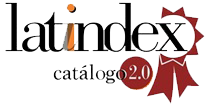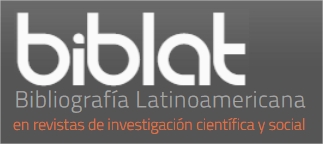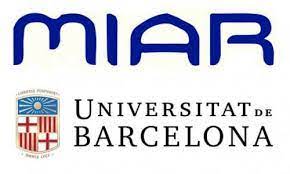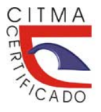Modeling of the adoption of artificial intelligence tools in higher education: a TAM -based approach
DOI:
https://doi.org/10.5281/zenodo.17653760Keywords:
artificial intelligence, higher education, technology adoption, perceived usefulnessAbstract
Introduction: artificial intelligence (AI) has emerged as one of the most transformative technologies in higher education, providing tools that facilitate personalized learning and optimize academic and administrative processes; however, its adoption depends on individual and organizational factors. Objective: to analyze the influence of perceived usefulness, ease of use, attitude, and intention to use on the adoption of AI tools among university students through the Technology Acceptance Model (TAM). Method: a quantitative descriptive-correlational approach was employed, applying a validated questionnaire to 55 students with prior experience in AI, and the data were processed using Pearson correlations and multiple regression analysis. Results: intention to use was identified as the most relevant predictor of actual use (β = 0.679, p < 0.001), followed by perceived usefulness (β = 0.374, p = 0.024), while ease of use had no significant impact, and attitude showed an inconclusive negative relationship. Conclusion: the TAM model proved pertinent in explaining the adoption of AI tools in higher education, highlighting that perceived usefulness and intention to use are the determining factors to ensure effective implementation of these technologies.
Downloads
References
Al Badi, A., Al Siyabi, N., Alsalmi, K., Al Handhali, K., Alsalmi, S., & Al-Kharusi, A. (2024). Factors affecting the use of Microsoft Teams® based on Technology Acceptance Model (TAM): Perspectives of teachers and students in higher education. In Proceedings of the 2024 8th International Conference on Digital Technology in Education (ICDTE) (pp. 13–21). Association for Computing Machinery. https://doi.org/10.1145/3696230.3696254
Al-Abdullatif, A. M. (2024). Modeling Teachers’ Acceptance of Generative Artificial Intelligence Use in Higher Education: The Role of AI Literacy, Intelligent TPACK, and Perceived Trust. Education Sciences, 14(11), 1209. https://doi.org/10.3390/educsci14111209
Amron, M. T., & Noh, N. H. M. (2021). Technology Acceptance Model (TAM) for analysing cloud computing acceptance in higher education institution (HEI). IOP Conference Series: Materials Science and Engineering, 1176(1), 012036. https://doi.org/10.1088/1757-899X/1176/1/012036
Barz, N., Benick, M., Dörrenbächer-Ulrich, L. & Perels, F. (2024). Students’ acceptance of e-learning: Extending the technology acceptance model with self-regulated learning and affinity for technology. Discovery Education, 3, 114. https://doi.org/10.1007/s44217-024-00195-7
Buana, A., & Linarti, U. (2021). Measurement of Technology Acceptance Model (TAM) in using e-learning in higher education. Jurnal Teknologi Informasi dan Pendidikan, 14(2), 165–171. https://doi.org/10.24036/tip.v14i2
Calle-Díaz, D. M., Porras-Cruz, F. L., & Santamaría-Freire, E. J. (2024). Modelo de aceptación tecnológica y la difusión de contenidos en estudiantes universitarios. MQRInvestigar, 8(4), 5685–5705. https://doi.org/10.56048/MQR20225.8.4.2024.5685-5705
Chintalapati, N., & Daruri, V. S. K. (2017). Examining the use of YouTube as a learning resource in higher education: Scale development and validation of TAM model. Telematics and Informatics, 34(6), 853–860. https://doi.org/10.1016/j.tele.2016.08.008
Contreras, F. C., & Guerrero, J. C. O. (2025). La integración de la IA en la educación superior: Una experiencia en el aprendizaje estudiantil. Revista Tribunal, 5 (11). https://doi.org/10.59659/revistatribunal.v5i11.140
Davis, F. D. (1989). Perceived usefulness, perceived ease of use, and user acceptance of information technology. MIS Quarterly, 13 (3), 319-340. https://doi.org/10.2307/249008
Fathema, N., Shannon, D., & Ross, M. (2015). Expanding the Technology Acceptance Model (TAM) to examine faculty use of learning management systems (LMSs) in higher education institutions. MERLOT Journal of Online Learning and Teaching, 11(2), 210–232. https://jolt.merlot.org/Vol11no2/Fathema_0615.pdf
Galdames, I. S. (2024). Integración de la Inteligencia Artificial en la Educación Superior: Relevancia para la Inclusión y el Aprendizaje. SciComm Report, 4(1). https://doi.org/10.32457/scr.v4i1.2487
Ibrahim, F., Münscher, J. C., Daseking, M., & Telle, N. T. (2025). The technology acceptance model and adopter type analysis in the context of artificial intelligence. Frontiers in Artificial Intelligence, 7. https://doi.org/10.3389/frai.2024.1496518
Kanont, K., Srisermbhok, A., Rungruang, P., & Boonprakob, M. (2024). Generative-AI, a learning assistant? Factors influencing higher-ed students' technology acceptance. The Electronic Journal of e-Learning, 22 (6), 18-33. https://doi.org/10.34190/ejel.22.6.3196
Morales, J. E. H. (2025). Adopción de herramientas de inteligencia artificial en la Universidad Francisco Gavidia. Realidad y Reflexión, 1 (60). https://doi.org/10.5377/ryr.v1i60.19866
Mourtajji, L., & Arts-Chiss, N. (2024). Unleashing ChatGPT: Redefining Technology Acceptance and Digital Transformation in Higher Education. Administrative Sciences, 14(12), 325. https://doi.org/10.3390/admsci14120325
Ngabiyanto, A., Nurkhin, A., Widiyanto, I. H. S., & Kholid, A. M. (2021). Teacher’s intention to use online learning: An extended technology acceptance model (TAM) investigation. Journal of Physics: Conference Series, 1783(1), 012123. https://doi.org/10.1088/1742-6596/1783/1/012123
Rosli, M. S., Saleh, N. S., Md. Ali, A., Abu Bakar, S., & Mohd Tahir, L. (2022). A Systematic Review of the Technology Acceptance Model for the Sustainability of Higher Education during the COVID-19 Pandemic and Identified Research Gaps. Sustainability, 14(18), 11389. https://doi.org/10.3390/su141811389
Sergeeva, O. V., Zheltukhina, M. R., Shoustikova, T., Tukhvatullina, L. R., Dobrokhotov, D. A., & Kondrashev, S. V. (2025). Understanding higher education students' adoption of generative AI technologies: An empirical investigation using UTAUT2. Contemporary Educational Technology, 17 (2), ep571. https://doi.org/10.30935/cedtech/16039
Sánchez-Prieto, J. C., Olmos-Migueláñez, S., & García-Peñalvo, F. J. (2016). Do Mobile Technologies Have a Place in Universities?: The TAM Model in Higher Education. In L. Briz-Ponce, J. Juanes-Méndez, & F. García-Peñalvo (Eds.), Handbook of Research on Mobile Devices and Applications in Higher Education Settings (pp. 25-52). IGI Global Scientific Publishing. https://doi.org/10.4018/978-1-5225-0256-2.ch002
Vanduhe, V. Z., Nat, M., & Hasan, H. F. (2020). Continuance intentions to use gamification for training in higher education: Integrating the Technology Acceptance Model (TAM), social motivation, and Task Technology Fit (TTF). IEEE Access, 8, 21473–21484. https://doi.org/10.1109/ACCESS.2020.2966179
Venkatesh, V., Morris, M. G., Davis, G. B., & Davis, F. D. (2003). User acceptance of information technology: Toward a unified view. MIS Quarterly, 27 (3), 425-478. https://doi.org/10.2307/30036540
Widodo, D. S., Rachmawati, D., Wijaya, H., Maghfuriyah, A., & Udriya, U. (2024). AI adoption in higher education institution: An integrated TAM and TOE model. Dinasti International Journal of Education Management and Social Science, 6 (2), 1029-1039. https://doi.org/10.38035/dijemss.v6i2.3645
Yong, L. A., Rivas Tovar, L. A., & Chaparro, J. (2010). Modelo de aceptación tecnológica (TAM): un estudio de la influencia de la cultura nacional y del perfil del usuario en el uso de las TIC. Innovar, 20(36), 187-203. http://www.scielo.org.co/scielo.php?script=sci_arttext&pid=S0121-50512010000100014&lng=en&tlng=es
Zambrano Vera, D. A., Castelo Naveda, M. del C., Zambrano Solís, M. J., & Vinocunga Pillajo, R. D. (2024). Adopción de Inteligencia Artificial Generativa en el ámbito educativo: Aplicación del Modelo de Aceptación Tecnológica. Polo del Conocimiento, 9 (12), 1983-1996. https://doi.org/10.1007/s10639-023-11816-3
Downloads
Published
How to Cite
Issue
Section
License
Copyright (c) 2025 Estrategia y Gestión Universitaria

This work is licensed under a Creative Commons Attribution-NonCommercial-ShareAlike 4.0 International License.

